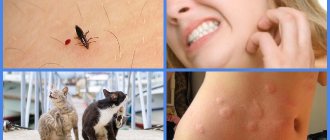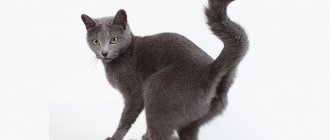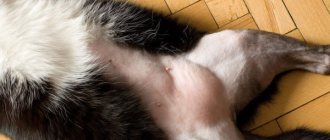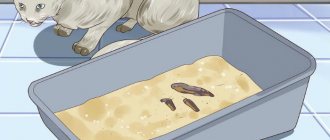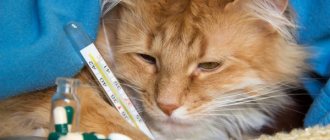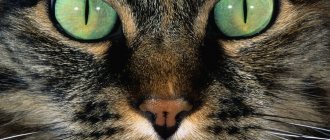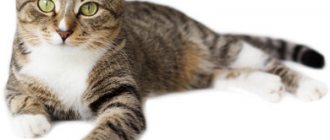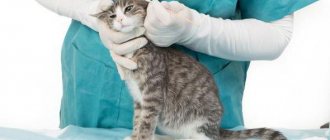The infestation of cats by fleas in cities and towns in Russia is usually seasonal and by the end of summer and autumn, up to 70% of cats are affected by this ectoparasite.
In nature, there are more than 100 species of fleas that infect our domestic animals, and some of them can attack humans.
Ctenocephalides felis (cat flea) is mainly found in cats. Simultaneously with cat fleas, cats can be attacked by fleas from dogs and rodents.
Morphology and development cycle.
Fleas are wingless insects. They have a bilaterally flattened body, covered with numerous spines and bristles, thanks to which fleas are held between the hairs of the cat's fur. The flea has six legs, the two back ones are more developed, thanks to which the flea has the ability to move in the cat’s hair at any angle and make long jumps, up to 1.5 meters. On the flea's abdomen there are special tactile hairs that are very sensitive to any air fluctuations. The chitinous cover protects the flea from any mechanical damage. Adults are brown in color, the size of the female is 2-2.3 mm, the size of the male is 2-2.5 mm. The mouthparts are piercing-sucking, simple eyes, epipharynx and antennae are located on the chitinous head. Adult fleas feed on the cat's blood. Sometimes they can feed on the blood of other animals. Blood enters the flea's stomach. Which has a volume of about 0.5µl, while at the same time, when sucking cat blood, the stomach can accommodate a blood volume 10-20 times larger. The flea's stomach is able to digest a small amount of blood consumed; most of the blood is released by the flea into the cat's hair in the form of small black feces. It has been noted that the flea has the ability to starve for several months. Upon external examination of flea-infested fur, we find a large amount of these feces, which look like poppy seeds.
The flea is an insect with a full development cycle. It has the stages of adult insect, egg, imago and pupa. The female flea lays her eggs wherever necessary, due to the absence of a sticky mass on its surface, from which after about 2 weeks a worm-like larva appears, which begins to grow, molting several times. Indoors, the larvae live in dust and debris, feeding on decaying organic matter and excrement. Later, the larva pupates and after some time an adult insect emerges from the pupa. The insect's lifespan is approximately 2 years. Parasites reproduce very actively; during her life, a female flea can lay up to 2 thousand eggs.
Pathogenesis. When fleas come into contact with a cat, they bite through the epidermis and begin to suck blood from the bitten capillaries. As a result of a massive flea infestation, a cat may develop multiple bites on its skin within a few minutes. The cat develops an allergic reaction to antigens that are present in the flea’s saliva and are introduced into the cat’s skin through bites, and allergic dermatitis appears. As a result of a flea bite with its infected blood, feline infectious anemia (hemobartonellosis), in which red blood cells are damaged, can be transmitted to a cat through a damaged membrane. It has been established that fleas contribute to the infection of cats with invasive diseases. In particularly sensitive cats, prolonged itching can develop even with a small number of fleas parasitizing the cat. As a result of constant itching, papules, scabs and bald patches appear on the cat's skin.
Clinical picture. A cat affected by fleas is accompanied by the presence of severely itchy areas on the body, and the cat not only constantly itches, but bites into the bite site with its teeth. As a result of constant scratching, the hair falls out in certain areas of the body (the neck area is most often affected), and the combed skin becomes covered with reddish crusts. Constant itching makes the cat nervous. During a clinical examination, the veterinarian finds flat miniature dots attached to the skin in the hair, similar in appearance to millet grains. Having drunk blood, fleas begin to move actively, and in some cases, jump. Using a magnifying glass, you can notice a dark brown, flat, elongated body measuring 2 or 3 mm, no wings, and long, jumping hind legs. In the depths of the fur near the skin, upon careful examination, a specialist finds waste products of fleas - dark-colored, fine-grained excrement. At the same time, upon careful examination, you can find flea eggs, which, unlike excrement, are oval in shape, larger and white in color.
In cats, as a result of flea infestation, complications often occur in the form of pyotraumatic dermatitis. With severe flea infestation, anemia is recorded as a result of a decrease in the amount of blood. Sometimes we note symptoms of lymphadenopathy and eosinophilia.
Unlike lice and lice eaters (which are parasitic bloodsuckers), fleas have great jumping ability when viewed, jumping up to a height of half a meter, and can move along the cat’s body, covering as much as 30 cm in one jump. While the louse crawls over its victim.
The diagnosis of a cat being affected by fleas is made based on the collected history, clinical picture of the disease, season and, of course, on the basis of the detection of fleas or flea feces. When making a diagnosis, you can resort to thorough combing of the fur with a thick comb. Place the particles combed out of the hair onto moistened filter paper. After a few minutes, a red zone appears around the combed out grains - representing flea feces with excess blood. The presence of a red zone is considered to be a diagnostic sign of a cat being affected by fleas, even if no living fleas are found. The disease is accompanied by the presence of eosinophilia in the cat.
Differential diagnosis. When conducting a differential diagnosis, veterinary specialists must exclude the presence of other ectoparasites (ticks, lice), dermatophytoses (ringworm, etc.), folliculitis, dietary disorders (lack of biotin, essential fatty acids), and food allergies in the cat.
What do fleas look like?
Fleas belong to a large order of insects, which include different subspecies. They feed on the blood of various animals and are parasites. Using a photo of fleas on a cat, you can determine the type of flea and understand that the animal is attacked by these insects.
The cat flea is one of the most common species; its body length reaches up to three millimeters. The flea has a body that is flattened on the sides, and their hind legs are very long.
- It is thanks to their long legs that they are so easily carried along the fur; female fleas are larger than males, since they lay eggs and carry them in their abdomen.
- The flea has a sucking and piercing mouth, with which it pierces the cat's skin and drinks its blood.
- There are many bristles on the surface of the flea's body, which also allows the parasite to cling tightly to the fur.
- The color of the flea can be light brown and reach black.
Features and signs of fleas
The flea is a small insect (from one to five millimeters in length) brown in color, has six legs with characteristic bristles. It differs from other external parasites (ear and ixodid mites, lice, lice eaters, coccidia) by its incredible jumping ability due to its long hind limbs. It has a special mouth mechanism designed to pierce and suck the blood of the host.
At optimal temperatures and humidity, a generation of fleas can grow in ten days, they spread very quickly and live up to two years. Larvae can develop both on the body of the host and in its habitat. In the house, this could be bedding or an animal’s house, carpets, or furniture upholstery.
The initial infection of a pet is impossible to notice, but as the insect colony develops, the signs become obvious:
- the cat shows increased anxiety;
- often itches and bites teeth into fur and skin;
- characteristic red dots appear on his body - places of bites, from single to numerous;
- appetite decreases;
- looks lethargic and apathetic - anemia develops;
- worms often appear;
- an allergy occurs.
Also read the article about why a cat may itch if it doesn't have fleas.
How do fleas get started?
There are many ways your pet can become infected with parasites.
- Walk outside (fleas can be on the grass, ground and asphalt).
- Human contact (fleas can be brought home on clothing or shoes).
- Transmission from the mother (if a pregnant cat has fleas, there is a high chance that the parasites will be transmitted to newborn kittens).
- Contact with rodents.
Morphology
The adult, like all fleas, is a small, wingless, blood-sucking insect. Body length ranges from 0.5 to 5 mm. When sucking blood, females can reach 16 mm. Body color is dark. They have cephalic and dental ctenidia. The head has 7 or 8 teeth of varying lengths located along the lower edge of the head, the thoracic has 14 or 16 teeth. The eyes are big. The anterior part of the antennal fossa is covered by the edge of the buccal lobe. The latter has a false tooth at the end. Both sexes have one developed prepygidial seta. The forehead is flat. Metepisternum has no more than two setae. The stigmas of the abdominal tergites are relatively small.
Sexual dimorphism. Individuals of different sexes differ in the structure of their genital organs.
Male. The handle of the sex claw is only slightly widened at the end.
Female. The forehead is flatter.
The egg is about 0.5 mm long, white.
Worm-shaped larva. The body is covered with long hairs and consists of three thoracic and ten abdominal segments (13 in total). It is eyeless, has short antennae and a chewing mouthparts. The maximum size of the third instar larvae is at least 5 mm.
Fleas: The Danger of Parasites
It is important to know that fleas on a domestic cat can be very dangerous for your pet.
- Fleas carry various diseases and even worm eggs.
- Because of the bites, wounds appear on the cat's skin, the fur becomes dull and begins to fall out.
- If the number of fleas constantly increases, this leads to feline anemia and negatively affects the health of the animal.
- Development of allergies.
Fleas particularly affect cats in poor health, as well as newborn kittens and older cats. In addition, the presence of fleas can be potentially dangerous for humans; if a flea gets into food, poisoning is possible. The parasite can bite through human skin, which will lead to dermatitis and various skin diseases.
Review of effective remedies
It is not always possible to independently select a suitable flea drug in the form of drops, since their range is quite extensive. Analyzing information from manufacturers, reviews, and the opinions of veterinarians, we can identify several popular brands that meet the criteria of safety and effectiveness.
Foreign manufacturers
- Hartz. American-made drops destroy flea larvae and oviposition. They should not be used on kittens under three months of age. Apply the product to the occipital area. The effect of the drug lasts for a month, after which the procedure is repeated. The protective effect is not reduced by short-term exposure to moisture. A preliminary consultation with a veterinarian will be required regarding the use of drops for pregnant cats, aging, and sick animals.
- Beaphar. In the line of Dutch-made flea drops, you can choose varieties for kittens and adult cats, including weakened and pregnant ones. The active ingredient is a natural margosa extract that is safe for animals. Convenient packaging in disposable ampoules is offered. The contents are poured onto the withers, lightly rubbing into the skin. By repeating the procedure every 30 days, you can completely protect your pet from fleas.
- Frontline. Due to the low degree of toxicity, drops produced in France by Frontline are approved for kittens from the age of two months. Formulations are used for cats, packaged in disposable pipettes with a volume of 0.5 ml. This drug is also used to rid animals of ear scabies. It must be taken into account that after processing light-colored breeds, the wool can change its original color.
- Advantage. When considering the best drops aimed at killing fleas in cats, it is necessary to note the German drug Advantage, the base substance of which is imidacloprid. Sold in tubes, the contents of which are squeezed onto the withers once a month. The drug is approved for kittens from two months. After treatment, it is necessary to ensure that small pets do not lick the insecticide within three hours.
- Advocate. These are effective drops made in Germany, which have proven themselves as an effective preventive measure. The drug Advocate is contraindicated in weakened animals and kittens under nine months of age.
- Zookeeper. The Belarusian-made drug is distinguished by lasting results after treating cats against fleas. Allowed for kittens two months old. Not recommended for weakened pets.
There is a type of drops that are part of a series of biological products. These include the German-developed Green Fort drug. It is safe because it contains natural ingredients. But it should be borne in mind that the effect of these drops is aimed only at repelling fleas. Therefore, they are more often used as prophylactic agents.
Russian-made drugs
- Bars drops, aimed at cats, have received the most widespread recognition. They destroy larvae and have a detrimental effect on insect eggs, maintaining the effect for almost three months.
- Dana-2 Ultra. The active component is low-toxic fipronil. These drops act quickly and effectively, but are recommended only for animals older than one year.
- The barrier is super. A drug that quickly destroys all generations of fleas. Allowed for kittens over three months old. The duration of exposure lasts two months.
- Inspector. Insecticidal drops that can destroy not only fleas, but also helminths. Prohibited for cats if skin damage is detected. Veterinarian permission is required for use by pregnant females and kittens weighing less than a kilogram.
- Celandine drops can be used by kittens from two months. The dosage is determined in accordance with the instructions and depends on the weight of the animal. If it is below 2 kg, then squeeze out half the contents of one pipette, that is, 0.5 ml. Pets from 3 to 5 kg require 1 ml, and over 5 and up to 10 kg - 2 ml. It is recommended to apply drops to the skin between the shoulder blades. The drug is prohibited for weak, sick animals, and pregnant cats.
Timely measures taken to combat fleas will save cats from serious consequences, such as hair loss, infection with dangerous diseases and allergic manifestations. Modern drops quickly rid animals of blood-sucking insects and show high effectiveness as preventative agents.
Symptoms of infection
Flea infestation has three main stages, each of which is accompanied by certain symptoms.
- Initial stage - at this stage, parasites can be detected if you carefully examine the cat's fur and skin.
- At the second stage, the pet’s health becomes worse, the cat becomes nervous and constantly chews something out of the fur, eats and sleeps poorly.
- The third stage is accompanied by severe hair loss, weight loss and anemia. Ulcers and redness are clearly visible on the cat’s skin.
It is important to notice the appearance of fleas in a cat in the early stages and begin treatment immediately.
Knowing how to remove fleas from a cat, you can help your pet recover and start living a full life without constant scratching and pain.
Appearance of the larvae
Flea larvae
What flea larvae look like depends on the stage of development. Initially they are born as white, translucent worms. Length does not exceed 1 mm. Their food consists of feces of adults, skin remains, and rot. They begin to eat actively.
Over time, worms accumulate in places where they can find food:
- dog bedding, cat mats;
- trash bins;
- baskets for storing vegetables, flower pots;
- pet toilet, feeders.
A week later, the first molt occurs. Flea larvae increase in size, but do not change appearance. The worms are already more like a caterpillar. The contents of the esophagus are visible through the transparent body. The color becomes dirty gray. During the entire developmental stage, the flea molts three times. Increases to 4 mm.
At the last stage of flea development, pupation occurs. The larva envelops itself in a cocoon and stops moving. Already after 2 days it emerges from there as an adult.
Removing fleas at home
If fleas are found on your pet, it is necessary to carry out a thorough general cleaning of the premises so that the parasites do not spread throughout the house.
Most often, flea eggs and the parasites themselves can be found on carpets and upholstered furniture, which should be vacuumed and treated with special products.
To remove fleas at home, you can use the following remedies.
- Special shampoo;
- Flea drops for cats;
- Spray;
- Medical collar;
- Pills;
The best option is to use several remedies that will give a positive effect. Many drugs can be dangerous for a cat, so it is advisable to consult a veterinarian or not use too aggressive drugs.
Ways to control fleas
The best way to get rid of flea bites and prevent their occurrence is prevention.
Simultaneously with treatment, insect extermination operations must be carried out. The entire house needs to be cleaned and sanitized. This is quite difficult, but prevention is better than subsequent treatment. After all, itching from a flea bite, swelling and redness are the mildest symptoms that may appear. The most effective method of killing insects is treating premises with chemicals. The most effective agents are chlorpyrifos, cypermethrin and others. Before processing, it is necessary to remove all sources of heat, since the preparations are highly flammable, close all food products and remove pets from the premises, because insecticides are very toxic.
After treatment, any remaining drug should be removed. Insecticide chemicals do not reach hidden areas (such as behind furniture) or affect pets, so these products must be used in combination with other methods for maximum effect.
Contact specialists who will carry out high-quality disinfection of the premises. Only professionals will be able to finally rid the room of harmful insects by treating the room with specialized means.
Flea prevention
The easiest way is not to treat your pet, but to prevent the appearance of parasites. It is important to keep your home clean and practice hygiene regularly. It is important to change and wash outer clothing, wash shoes, and keep the floor clean.
If your pet goes outside, it needs to be bathed and its paws washed. If your cat is often outdoors, use a flea-repellent collar.
They contain a special flea remedy for cats, which repels parasites and prevents them from settling in the animal’s fur. It is important to change such a collar on time, taking into account their expiration date.
The positive properties of the collar include the following qualities:
- Easy to use.
- Suitable for animals that do not like water treatments.
- Protection not only from fleas, but also from ticks.
- Can be used by pregnant cats and small kittens.
How to remove lice from a cat. Treatment methods
To solve the problem of lice infestation in cats, special insectoacaricidal preparations are used. When using them, it is important to strictly follow the instructions for use. Be sure to read all contraindications to avoid side effects.
To treat lice in cats use:
- Drops on the withers. Drops are applied at the base of the skull or along the spine. The procedure takes only a few minutes. The drug usually not only helps get rid of existing lice in a cat, but also helps protect the pet from new attacks by parasites.
- Sprays. The spray moisturizes the animal's fur. During such processing, maximum care must be taken to avoid harm to the animal. After applying the product, wait until it dries and make sure that the animal does not lick it off. For this purpose, it is recommended to wear a protective collar. Sprays are also used to kill parasites indoors and in animal resting places (houses, sofas, armchairs).
Traditional methods for fleas
If for some reason you do not want to use store-bought flea products, you can turn to traditional medicine and rid your pet of parasites.
- It is necessary to prepare an infusion of celandine and salt, in which the cat must be thoroughly bathed and allowed to stand in this water. For 50 grams of celandine, take 1 liter of water.
- Two or three cloves of garlic need to be turned into a liquid pulp and mixed with 700 ml of water. This infusion must be rubbed into the cat's fur at night, and the pet must be combed in the morning.
- A strong infusion is made from dry and fresh wormwood. The product is applied to the cat's fur, then the animal must be bathed with shampoo and combed well.
Preparations for home treatment
For flea control to be effective, your home must also be treated for parasites. First you need to clean all soft objects (toys, blanket, carpet, etc.). Then you should pack them in cellophane, and also hide all food and utensils in containers or bags. Only then can you treat the house for parasites. You should always read the instructions on how to use a particular product.
At the end of the procedure, it is imperative to ventilate the apartment and clean it with a vacuum cleaner, reaching every corner and crack. When dry cleaning is completed, you should treat the vacuum cleaner with Dichlorvos or another anti-flea product so that it does not become a new refuge for parasites. At the end, you need to carry out a thorough wet cleaning of the entire apartment.
There are four ways to kill fleas in an apartment:
- use of aerosol;
- powder application;
- temperature treatment;
- calling specialists (the best and easiest method).
Aerosols and sprays
Before using the aerosol, you need to:
- vacuum the room;
- remove animals and people not involved in this process;
- close doors and windows.
The best anti-flea aerosols:
- Flee (contains cyclopentasiloxane and dimethicone);
- “Clean house” (after a few hours, the treated apartment is safe for people even without wet treatment, but the product does not destroy parasite eggs, so repeated treatment is required);
- Raptor (low price but quite effective).
The price of these aerosols is not less than 300 rubles.
In order to get rid of fleas, you also need to treat the house
Flea powders
Cleaning your home from fleas using powder requires a lot of time. The powder should be poured into places where parasite larvae accumulate.
The most reputable flea powders are:
- "Phenaxin" (highly toxic drug);
- "Pyrethrune".
A package of 125 g of Phenaxin can cost 50 rubles. But with Pyrethrun it is more difficult to find on sale, so it is very difficult to determine the price of the finished drug. Even on the official website it is negotiated separately with each buyer.
Temperature treatment of the room
The essence of the method of temperature treatment of a room is either to lower the temperature in the apartment to minus 20 °C, or to burn out fleas at +50 °C. This method is only available to specialists when using heat guns.
Insecticides: Rules for use
Flea allergies in cats can have dire consequences, so it is best to use proven insecticides that will give positive results.
- Under no circumstances should the insecticide come into contact with the cat’s mucous membranes;
- The cat should not reach with its tongue the place where its fur was treated with drops;
- Spray treatment should be carried out carefully; the spray should not come into contact with the cat’s eyes, nose and mouth;
- After treating your pet, you need to ventilate the room;
If the product gets on the mucous membrane, you need to rinse it with plenty of clean water.
Consequences for the cat
Ectoparasite bites cause a lot of unpleasant and painful sensations, which often affects the health of an adult cat and, especially, a small kitten. Signs of flea bites on a cat are red, inflamed dots on the skin.
With a large number of ectoparasites, the following negative consequences are possible:
- when an infection gets into the wound, inflammation can begin, the formation of sores and crusts, which the animal rips off and continues scratching;
- furunculosis and ulcers on the skin, the formation of pustules and pustules;
- skin irritations contribute to the appearance of allergic dermatitis or dermatophiliasis;
- loss of tufts of hair in places where there are many bites, which leads to swelling of the affected area.
Therefore, it is very important to quickly rid your pet of these parasites so that you do not have to treat the negative consequences after their bites. Moreover, it is necessary to treat not only his fur, but also the entire room where he lives and sleeps.
How to avoid re-infection
Repeated flea attacks on a cat can only be avoided if control agents are periodically used as a preventive measure and the room is cleaned regularly.
When walking a cat, be sure to wear a collar, apply drops or treat with a spray. When bathing your pet, it is recommended to alternate regular shampoo with anti-flea shampoo.
The room must be periodically wet cleaned using hot water. You should also wash combs, brushes and toys. Once a month, it is advisable to treat upholstered furniture and carpets in the house with aerosol preparations against fleas and ticks.
Every cat owner must maintain personal hygiene: wash hands, put shoes and street clothes in the closet, especially if there was interaction with other animals outside the home.
Peculiarities
These insects do not have wings, but thanks to their strong hind legs, they can jump long distances. The body of the parasite is flattened on the sides and slightly elongated in height. This structure of the body gives it the ability to move in the fur with lightning speed.
The dense cover and flattened appearance protect insects well - even if you catch a flea, you cannot kill it with your fingers alone; you must crush the parasite with your fingernail. This invulnerability allows fleas to bite as painfully as possible.
It differs from other relatives - rat and dog fleas, as well as those that parasitize cats, in its smaller size. Also, her backside is not raised, like a rat's. It is worth noting that such nuances are almost impossible to see with the naked eye.
Why are cat fleas dangerous?
The parasites do not disguise themselves during the bite and do not inject anesthetic substances into the puncture site. Flea saliva contains an enzyme that has a protein structure and provokes allergic reactions. Symptoms of a flea bite:
- pain;
- severe itching;
- the appearance of red blisters and swelling.
Regular attacks by bloodsuckers can lead to weakening, decreased immunity, and anemia of the cat. Fleas carry about 25 dangerous viruses and helminth eggs, so you should fight parasites at the first sign of their appearance.
Review
It is very easy to detect fleas on a cat. If you have a pet with light fur, just spread the hair with a comb and you will notice small dark dots moving in the fur. To examine a dark-colored cat, it is better to lay down a white sheet - when combing, brown insects will fall off and are easy to recognize against a light background.
Yulia, Saratov
Lice and lice eaters
These arthropods can be safely combined into one group, because they are “terribly similar,” although they belong to different orders. Lice are most often Felicola subrostratus, lice eaters are Mallophaga.
What do lice and lice look like?
- The body, just like a flea’s, is flat, up to 2-3 mm long. Color – light beige or transparent white.
- The head is wider than the chest, flat, quadrangular.
- The eyes are poorly developed.
- The abdomen is also wider than the chest and longer than the chest and head combined!
- The oral apparatus is not adapted to pierce the skin and suck out blood, and, despite the fact that it is considered gnawing, neither the louse nor the lice eater are capable of inflicting wounds on the owner.
These creatures are capable of gnawing only with the upper part of the mouth opening, which is used to “saw off” the wide lower end of the hair or dead parts of the epidermis, which curl upward when dry. This leads to ringworm-type baldness and frequent dandruff.
And also - nits. These are lice and lice eggs.
How do lice reproduce on a cat?
They are specific in relation to the owner, because they spend their entire life on his body, because have incomplete transformation - they will never grow long, strong legs that can help them jump up to 1 m in height, like a flea. Simply put, the louse and the lice eater are “unfinished” fleas.
The females of these “unfinished” eggs lay up to 100 eggs, which are attached to the root part of the hair with special glue - uterine secretion. The whitish tiny balls visible at the root of the hair are nits of specific permanent entomoses.
After 7-12 days (it all depends on the species and environmental conditions), these nits hatch into larvae that are similar in appearance to the adult. Over the next 12-20 days, the larva molts 3 times and turns into a sexually mature individual, which immediately begins its life activity - firmly clings with its paws and claws to the root of the hair and begins to gnaw it and drink blood.
Appearance
This is what cat parasites look like:
Cat fleas are also dangerous for humans
In most cases, in cities and villages, it is cat fleas that attack people and pets.
As a rule, in populated areas, humans and domestic animals can be attacked by a feline representative of the species. This type of insect is the most unpleasant and dangerous; this parasite sucks blood even from rodents, not to mention humans. We have already told you where it comes from in your pet.
A hungry flea looks for a warm-blooded animal in search of food. Her huge eyes and heightened sense of smell help her find her prey faster; she attacks the first object she comes across that is within her range of vision - it can be a person or a cat. Having jumped onto the victim, the insect attaches itself to the body and bites. Having eaten, it leaves its object and sits in a secluded place.
The cat species of fleas, attacking rodents, begins to fight rat parasites, and ultimately displaces them.
